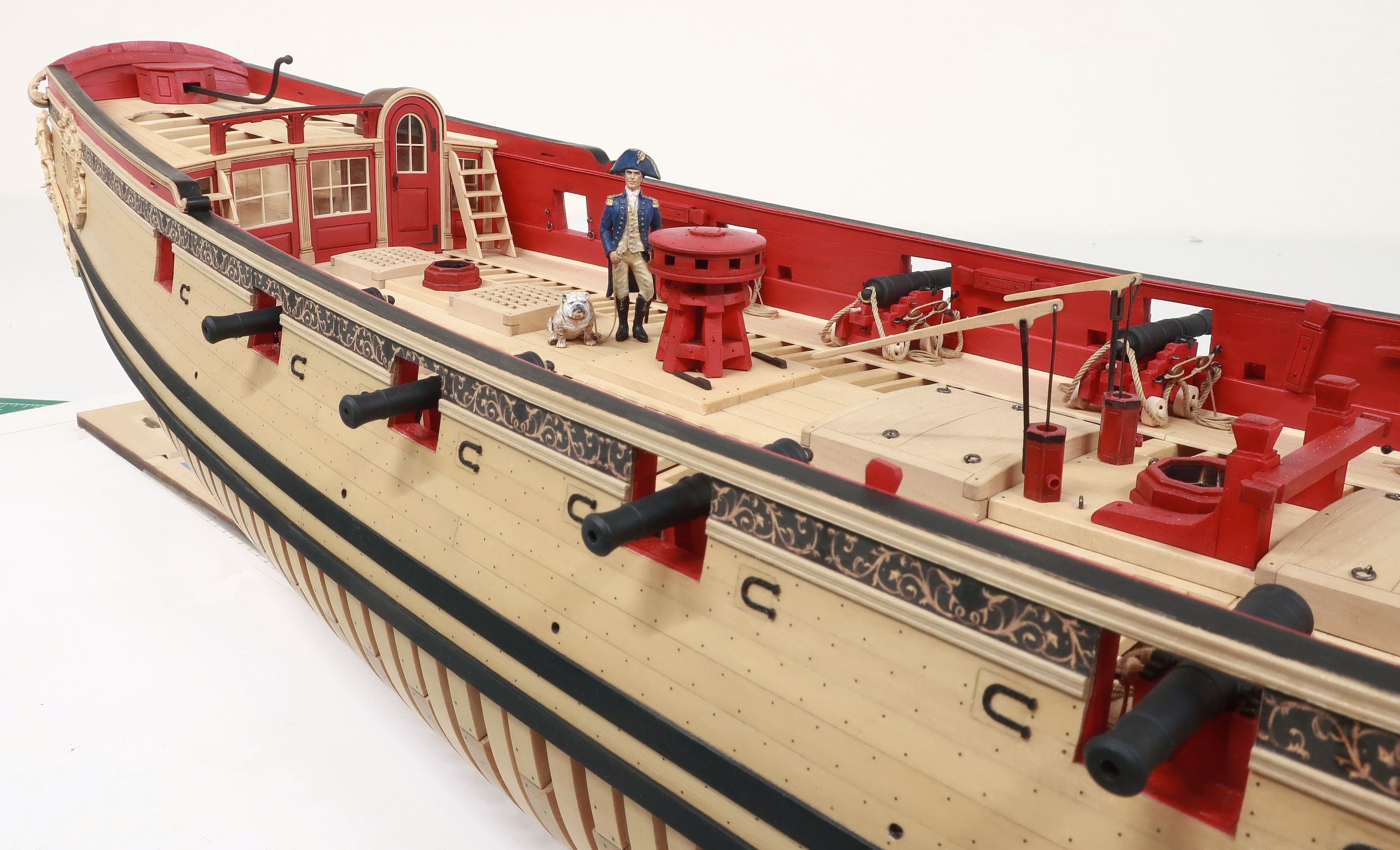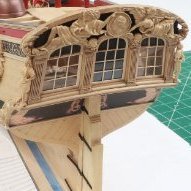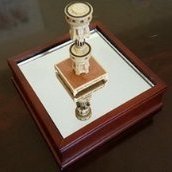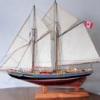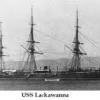Check out our new MSW Sponsor Innocraftsman
×
-
Posts
9,627 -
Joined
-
Last visited
Reputation Activity
-
 Chuck got a reaction from fatih79 in HM Cutter Cheerful 1806 by Chuck - FINISHED - 1:48 scale - kit prototype
Chuck got a reaction from fatih79 in HM Cutter Cheerful 1806 by Chuck - FINISHED - 1:48 scale - kit prototype
Thanks Ken....maybe a future tech session at the club. But there really isnt much to say. Its done the same exact exact way that so many folks make them.
I just wrap the rope around a dowel. I try and use the smallest amount of white glue...just on the top of the coil.
Thats the real trick....try not to handle them too much and certainly less glue is better...watered down white glue. Otherwise the rope gets mashed and you stick to it and pull fuzz up from it. Keep your rope clean. Less handling is key with clean fingers.
Then I take one of the hanging coils and wrap it around the top tightly to form the handle....so-to-speak. Wrap it around the coil from the inside. Twice around does the trick.
By the way, none of the belaying pins are glued into position yet. These coils are just temporary placed on top of them at this point...I will eventually just pull them off and store them in a box until rigging begins.
Also its just a great idea to experiment and make them well ahead of time. You will need to use more than just one size. Test them out before rigging begins. Here are the five or six coils I will eventually hang on this rail. You need to use thicker rope sometimes...how does it effect the rope its hanging next to? How do you need to bend it so it hangs nicely in front of or in back of the coils next to it? Should I vary the length of the coils a bit so its not to uniform? Does it look too messy and hap-hazard? These are the questions I am pondering at the moment. I am just fumbling through it like everyone else. The rails will fill up quickly and it gets harder to make them look natural. Better to have a test run now rather than when you have all of that rigging.....shrouds....and backstays.....in the way. Its just too frustrating then. It becomes an after thought almost. Because such a large grouping of rope on these pin rails becomes an important focal point...its a good idea to spend more time on it rater than wait. Otherwise it will detract from all of the other hard work you did.
Take a lot of photos of your test run from various angles as well. Its a huge help. I am still fussin....these close-up photos are brutal. It often looks so much better just viewing the model first hand. The naked eye can never see this level of detail as shown in the macro shots.
Chuck
-
 Chuck got a reaction from robin b in HM Cutter Cheerful 1806 by Chuck - FINISHED - 1:48 scale - kit prototype
Chuck got a reaction from robin b in HM Cutter Cheerful 1806 by Chuck - FINISHED - 1:48 scale - kit prototype
I am not sure I agree with you Kester. But I do think that is what makes the hobby interesting. For now the coils will stay as is. I think they look head over over heels better than most other attempts I have seen and I can live with them. There is always the next model too!!! I have never seen so much scrutiny on rope coils.
I am just glad they came out neatly. Most times I see them modeled they look like they been smashed together from over handling and too much glue. Just getting a clean coil for a change is a welcome thing.
Chuck
-
 Chuck reacted to overdale in Frigate Boston by overdale - FINISHED
Chuck reacted to overdale in Frigate Boston by overdale - FINISHED
The masts are rising and the rigging is underway.!
Dan.
-
 Chuck reacted to Erik W in HM Cutter Cheerful 1806 by Erik W - 1:48 scale
Chuck reacted to Erik W in HM Cutter Cheerful 1806 by Erik W - 1:48 scale
Since my progress is slow and steady . . . you get photos of every little step forward! I added the molding strips on each side, just below the gun ports. These were actually quite challenging to get a smooth run since they're so narrow. It's easy to accidentally kink them. The first side I did I wound up pulling off and reattaching the main strip 4 times, and the short strip in front of the forward gun port 2 times. I blame Mike (Stuntflyer) for setting the example of pulling things apart and starting over. The second side went much smoother with no need to start over.
Erik
-
 Chuck got a reaction from Nirvana in HM Cutter Cheerful 1806 by Erik W - 1:48 scale
Chuck got a reaction from Nirvana in HM Cutter Cheerful 1806 by Erik W - 1:48 scale
Very nice...smooth run for the planking to come.
-
 Chuck got a reaction from druxey in HM Cutter Cheerful 1806 by Chuck - FINISHED - 1:48 scale - kit prototype
Chuck got a reaction from druxey in HM Cutter Cheerful 1806 by Chuck - FINISHED - 1:48 scale - kit prototype
Thank you very much. My guess is that yes the cutter would have had a king plank possibly...but I have never seen one on a contemporary model or on a plan. So rather than guess what it would look like I went with a straight up center plank the same size as the others. These were very small ships so either way would work in my opinion.
Chuck
-
 Chuck got a reaction from canoe21 in HM Cutter Cheerful 1806 by Chuck - FINISHED - 1:48 scale - kit prototype
Chuck got a reaction from canoe21 in HM Cutter Cheerful 1806 by Chuck - FINISHED - 1:48 scale - kit prototype
Thanks Ken....maybe a future tech session at the club. But there really isnt much to say. Its done the same exact exact way that so many folks make them.
I just wrap the rope around a dowel. I try and use the smallest amount of white glue...just on the top of the coil.
Thats the real trick....try not to handle them too much and certainly less glue is better...watered down white glue. Otherwise the rope gets mashed and you stick to it and pull fuzz up from it. Keep your rope clean. Less handling is key with clean fingers.
Then I take one of the hanging coils and wrap it around the top tightly to form the handle....so-to-speak. Wrap it around the coil from the inside. Twice around does the trick.
By the way, none of the belaying pins are glued into position yet. These coils are just temporary placed on top of them at this point...I will eventually just pull them off and store them in a box until rigging begins.
Also its just a great idea to experiment and make them well ahead of time. You will need to use more than just one size. Test them out before rigging begins. Here are the five or six coils I will eventually hang on this rail. You need to use thicker rope sometimes...how does it effect the rope its hanging next to? How do you need to bend it so it hangs nicely in front of or in back of the coils next to it? Should I vary the length of the coils a bit so its not to uniform? Does it look too messy and hap-hazard? These are the questions I am pondering at the moment. I am just fumbling through it like everyone else. The rails will fill up quickly and it gets harder to make them look natural. Better to have a test run now rather than when you have all of that rigging.....shrouds....and backstays.....in the way. Its just too frustrating then. It becomes an after thought almost. Because such a large grouping of rope on these pin rails becomes an important focal point...its a good idea to spend more time on it rater than wait. Otherwise it will detract from all of the other hard work you did.
Take a lot of photos of your test run from various angles as well. Its a huge help. I am still fussin....these close-up photos are brutal. It often looks so much better just viewing the model first hand. The naked eye can never see this level of detail as shown in the macro shots.
Chuck
-
 Chuck got a reaction from Bobstrake in HM Cutter Cheerful 1806 by Chuck - FINISHED - 1:48 scale - kit prototype
Chuck got a reaction from Bobstrake in HM Cutter Cheerful 1806 by Chuck - FINISHED - 1:48 scale - kit prototype
Thank you very much. My guess is that yes the cutter would have had a king plank possibly...but I have never seen one on a contemporary model or on a plan. So rather than guess what it would look like I went with a straight up center plank the same size as the others. These were very small ships so either way would work in my opinion.
Chuck
-
 Chuck got a reaction from Canute in HM Cutter Cheerful 1806 by Stuntflyer (Mike) - FINISHED - 1:48 scale
Chuck got a reaction from Canute in HM Cutter Cheerful 1806 by Stuntflyer (Mike) - FINISHED - 1:48 scale
Looks good Mike.....
-
 Chuck got a reaction from paulsutcliffe in HM Cutter Cheerful 1806 by Chuck - FINISHED - 1:48 scale - kit prototype
Chuck got a reaction from paulsutcliffe in HM Cutter Cheerful 1806 by Chuck - FINISHED - 1:48 scale - kit prototype
Thank you very much. My guess is that yes the cutter would have had a king plank possibly...but I have never seen one on a contemporary model or on a plan. So rather than guess what it would look like I went with a straight up center plank the same size as the others. These were very small ships so either way would work in my opinion.
Chuck
-
 Chuck got a reaction from Elijah in The Ship that Held Up Wall Street By Warren C. Riess
Chuck got a reaction from Elijah in The Ship that Held Up Wall Street By Warren C. Riess
The Ship that Held Up Wall Street
By Warren C. Riess with Sheli O. Smith
College Station: Texas A&M University Press, 2014
8-3/4” x 11-1/4”, hardcover, 112 pages
Illustrations, diagrams, sketch maps, notes, glossary, index. $29.00
ISBN: 9781623491888
In January 1982 a backhoe digging a trench at a New York City construction site uncovered the remains of a buried ship—an old one. The trench, one of four, was part of an archeological survey prior to clearing the site for the foundations of a thirty-story office building in Manhattan’s financial district.
It was soon apparent the ship likely dated from the early eighteenth century. It offered insights on a little-understood period of naval architecture. Construction could be delayed for only a short time. Any study or recovery of the ship in situ had to be completed by March 1.
The Ship that Held Up Wall Street, by Warren C. Riess with Sheli O. Smith, tells what happened next. It reveals the story of a month-long sprint to unearth the ship and the decades-long marathon to unlock the secrets of the find.
The book opens describing the 28-day site dig. Riess relates an urban adventure worthy of an Indiana Jones movie. The excavation took place in February in pre-Giuliani New York City. The archeologists not only had to fight time and February weather, they had to contend with picket lines and gang violence. (Local community activists protested the lack of minority workers at the dig site until they learned the diggers were low-paid archeologists, not high-paid construction workers. A street gang attempted to fire-bomb the ship for reasons still unknown.)
This is followed by a section describing preservation of artifacts and explains what was chosen for preservation and why. It provides a clear, understandable introduction to the science behind stabilizing fragile timber and artifacts.
Riess next unravels the identity of the ship uncovered by construction. The chapter reads like a first-rate mystery novel, as Reiss pieces clues together. Evidence as diverse as the design of the ship, the timber used in construction, and even the species of shipworm which attacked the hull provided critical data. Combined with archival research, it allowed a tentative identification of the ship.
For those most interested in sailing era naval architecture, this is likely the most fascinating chapter. The ship is revealed as a transitional design, a cross between the Dutch fluyte (or flyboat) and British merchant frigate. It was significant find.
After developing the probable career of the ship, Riess explains how and why this ship ended up buried one-tenth of a mile from Manhattan’s present coast. To do this he examines the history of early eighteenth-century New York City. He takes readers into the commercial life of the city, and introduces them to the individuals who developed the lot in the 1740s and 1750s.
The Ship that Held Up Wall Street is a delightful book on several levels. In addition to adventure, mystery, and history, Riess introduces touches of comedy and tragedy describing missteps, near-catastrophe, and dropped opportunities occurring in every effort with tight deadlines and many participants.
The only real disappointment—for model-makers—is a lack of technical detail about the ship’s design and construction. Riess promises that in a second book about the ship, one he is currently preparing. The Ship that Held Up Wall Street will hold model-makers until then.
Mark Lardas
League City, Texas
-
 Chuck got a reaction from justsayrow in HM Cutter Cheerful 1806 by Chuck - FINISHED - 1:48 scale - kit prototype
Chuck got a reaction from justsayrow in HM Cutter Cheerful 1806 by Chuck - FINISHED - 1:48 scale - kit prototype
Thanks Ken....maybe a future tech session at the club. But there really isnt much to say. Its done the same exact exact way that so many folks make them.
I just wrap the rope around a dowel. I try and use the smallest amount of white glue...just on the top of the coil.
Thats the real trick....try not to handle them too much and certainly less glue is better...watered down white glue. Otherwise the rope gets mashed and you stick to it and pull fuzz up from it. Keep your rope clean. Less handling is key with clean fingers.
Then I take one of the hanging coils and wrap it around the top tightly to form the handle....so-to-speak. Wrap it around the coil from the inside. Twice around does the trick.
By the way, none of the belaying pins are glued into position yet. These coils are just temporary placed on top of them at this point...I will eventually just pull them off and store them in a box until rigging begins.
Also its just a great idea to experiment and make them well ahead of time. You will need to use more than just one size. Test them out before rigging begins. Here are the five or six coils I will eventually hang on this rail. You need to use thicker rope sometimes...how does it effect the rope its hanging next to? How do you need to bend it so it hangs nicely in front of or in back of the coils next to it? Should I vary the length of the coils a bit so its not to uniform? Does it look too messy and hap-hazard? These are the questions I am pondering at the moment. I am just fumbling through it like everyone else. The rails will fill up quickly and it gets harder to make them look natural. Better to have a test run now rather than when you have all of that rigging.....shrouds....and backstays.....in the way. Its just too frustrating then. It becomes an after thought almost. Because such a large grouping of rope on these pin rails becomes an important focal point...its a good idea to spend more time on it rater than wait. Otherwise it will detract from all of the other hard work you did.
Take a lot of photos of your test run from various angles as well. Its a huge help. I am still fussin....these close-up photos are brutal. It often looks so much better just viewing the model first hand. The naked eye can never see this level of detail as shown in the macro shots.
Chuck
-
 Chuck got a reaction from Erik W in HM Cutter Cheerful 1806 by Stuntflyer (Mike) - FINISHED - 1:48 scale
Chuck got a reaction from Erik W in HM Cutter Cheerful 1806 by Stuntflyer (Mike) - FINISHED - 1:48 scale
Looks good Mike.....
-
 Chuck got a reaction from druxey in HM Cutter Cheerful 1806 by Chuck - FINISHED - 1:48 scale - kit prototype
Chuck got a reaction from druxey in HM Cutter Cheerful 1806 by Chuck - FINISHED - 1:48 scale - kit prototype
Thanks!! That is a common misconception with carronades. Especially on revenue cutters. Along with the notion that all revenue cutters were clinker planked. You would be surprised how many variations there are.
-
 Chuck got a reaction from CharlieZardoz in HM Cutter Cheerful 1806 by Chuck - FINISHED - 1:48 scale - kit prototype
Chuck got a reaction from CharlieZardoz in HM Cutter Cheerful 1806 by Chuck - FINISHED - 1:48 scale - kit prototype
Thanks Ken....maybe a future tech session at the club. But there really isnt much to say. Its done the same exact exact way that so many folks make them.
I just wrap the rope around a dowel. I try and use the smallest amount of white glue...just on the top of the coil.
Thats the real trick....try not to handle them too much and certainly less glue is better...watered down white glue. Otherwise the rope gets mashed and you stick to it and pull fuzz up from it. Keep your rope clean. Less handling is key with clean fingers.
Then I take one of the hanging coils and wrap it around the top tightly to form the handle....so-to-speak. Wrap it around the coil from the inside. Twice around does the trick.
By the way, none of the belaying pins are glued into position yet. These coils are just temporary placed on top of them at this point...I will eventually just pull them off and store them in a box until rigging begins.
Also its just a great idea to experiment and make them well ahead of time. You will need to use more than just one size. Test them out before rigging begins. Here are the five or six coils I will eventually hang on this rail. You need to use thicker rope sometimes...how does it effect the rope its hanging next to? How do you need to bend it so it hangs nicely in front of or in back of the coils next to it? Should I vary the length of the coils a bit so its not to uniform? Does it look too messy and hap-hazard? These are the questions I am pondering at the moment. I am just fumbling through it like everyone else. The rails will fill up quickly and it gets harder to make them look natural. Better to have a test run now rather than when you have all of that rigging.....shrouds....and backstays.....in the way. Its just too frustrating then. It becomes an after thought almost. Because such a large grouping of rope on these pin rails becomes an important focal point...its a good idea to spend more time on it rater than wait. Otherwise it will detract from all of the other hard work you did.
Take a lot of photos of your test run from various angles as well. Its a huge help. I am still fussin....these close-up photos are brutal. It often looks so much better just viewing the model first hand. The naked eye can never see this level of detail as shown in the macro shots.
Chuck
-
 Chuck reacted to AndrewNaylor in HM Cutter Cheerful 1806 by Chuck - FINISHED - 1:48 scale - kit prototype
Chuck reacted to AndrewNaylor in HM Cutter Cheerful 1806 by Chuck - FINISHED - 1:48 scale - kit prototype
On coiling ropes
Working on a yacht for the past 30 years I have coiled a few. Been right hander and most importunely the LAY of the rope dictates which way the rope naturally coils. They all go clockwise So be very careful if the ones on the right of the canon coil to the right with the tail on the bottom Correct, and the one on the left coil anti clockwise with the tail on the top WRONG. If the tail is on the bottom the rope pulls cleanly from the top. if the tail is on the top the rope pulls from the bottom and gets tangled ,Not so good.
I sit from afar and watch this beautiful work been created, so we can try with our dull minds and tools the replicate (the tools can be sharpened)
Chuck Thank you so much for all your hard work
Andy
-
 Chuck got a reaction from fatih79 in HM Cutter Cheerful 1806 by Chuck - FINISHED - 1:48 scale - kit prototype
Chuck got a reaction from fatih79 in HM Cutter Cheerful 1806 by Chuck - FINISHED - 1:48 scale - kit prototype
Rope coils take two......I hate waiting for repair guys to show up so in the spirit of trying all things to show folks different looks. Here are some less then perfect deck coils. Not too much difference but maybe enough to make it presentable.
-
 Chuck got a reaction from Bobstrake in HM Cutter Cheerful 1806 by Chuck - FINISHED - 1:48 scale - kit prototype
Chuck got a reaction from Bobstrake in HM Cutter Cheerful 1806 by Chuck - FINISHED - 1:48 scale - kit prototype
I am not sure I agree with you Kester. But I do think that is what makes the hobby interesting. For now the coils will stay as is. I think they look head over over heels better than most other attempts I have seen and I can live with them. There is always the next model too!!! I have never seen so much scrutiny on rope coils.
I am just glad they came out neatly. Most times I see them modeled they look like they been smashed together from over handling and too much glue. Just getting a clean coil for a change is a welcome thing.
Chuck
-
 Chuck got a reaction from Jack12477 in HM Cutter Cheerful 1806 by Stuntflyer (Mike) - FINISHED - 1:48 scale
Chuck got a reaction from Jack12477 in HM Cutter Cheerful 1806 by Stuntflyer (Mike) - FINISHED - 1:48 scale
Looks good Mike.....
-
 Chuck got a reaction from Canute in HM Cutter Cheerful 1806 by Chuck - FINISHED - 1:48 scale - kit prototype
Chuck got a reaction from Canute in HM Cutter Cheerful 1806 by Chuck - FINISHED - 1:48 scale - kit prototype
Thank you very much. My guess is that yes the cutter would have had a king plank possibly...but I have never seen one on a contemporary model or on a plan. So rather than guess what it would look like I went with a straight up center plank the same size as the others. These were very small ships so either way would work in my opinion.
Chuck
-
 Chuck got a reaction from robin b in HM Cutter Cheerful 1806 by Chuck - FINISHED - 1:48 scale - kit prototype
Chuck got a reaction from robin b in HM Cutter Cheerful 1806 by Chuck - FINISHED - 1:48 scale - kit prototype
Thanks Ken....maybe a future tech session at the club. But there really isnt much to say. Its done the same exact exact way that so many folks make them.
I just wrap the rope around a dowel. I try and use the smallest amount of white glue...just on the top of the coil.
Thats the real trick....try not to handle them too much and certainly less glue is better...watered down white glue. Otherwise the rope gets mashed and you stick to it and pull fuzz up from it. Keep your rope clean. Less handling is key with clean fingers.
Then I take one of the hanging coils and wrap it around the top tightly to form the handle....so-to-speak. Wrap it around the coil from the inside. Twice around does the trick.
By the way, none of the belaying pins are glued into position yet. These coils are just temporary placed on top of them at this point...I will eventually just pull them off and store them in a box until rigging begins.
Also its just a great idea to experiment and make them well ahead of time. You will need to use more than just one size. Test them out before rigging begins. Here are the five or six coils I will eventually hang on this rail. You need to use thicker rope sometimes...how does it effect the rope its hanging next to? How do you need to bend it so it hangs nicely in front of or in back of the coils next to it? Should I vary the length of the coils a bit so its not to uniform? Does it look too messy and hap-hazard? These are the questions I am pondering at the moment. I am just fumbling through it like everyone else. The rails will fill up quickly and it gets harder to make them look natural. Better to have a test run now rather than when you have all of that rigging.....shrouds....and backstays.....in the way. Its just too frustrating then. It becomes an after thought almost. Because such a large grouping of rope on these pin rails becomes an important focal point...its a good idea to spend more time on it rater than wait. Otherwise it will detract from all of the other hard work you did.
Take a lot of photos of your test run from various angles as well. Its a huge help. I am still fussin....these close-up photos are brutal. It often looks so much better just viewing the model first hand. The naked eye can never see this level of detail as shown in the macro shots.
Chuck
-
 Chuck got a reaction from mtaylor in HM Cutter Cheerful 1806 by Chuck - FINISHED - 1:48 scale - kit prototype
Chuck got a reaction from mtaylor in HM Cutter Cheerful 1806 by Chuck - FINISHED - 1:48 scale - kit prototype
Thank you very much. My guess is that yes the cutter would have had a king plank possibly...but I have never seen one on a contemporary model or on a plan. So rather than guess what it would look like I went with a straight up center plank the same size as the others. These were very small ships so either way would work in my opinion.
Chuck
-
 Chuck got a reaction from robin b in HM Cutter Cheerful 1806 by Chuck - FINISHED - 1:48 scale - kit prototype
Chuck got a reaction from robin b in HM Cutter Cheerful 1806 by Chuck - FINISHED - 1:48 scale - kit prototype
Thanks!! That is a common misconception with carronades. Especially on revenue cutters. Along with the notion that all revenue cutters were clinker planked. You would be surprised how many variations there are.
-
 Chuck got a reaction from druxey in HM Cutter Cheerful 1806 by Chuck - FINISHED - 1:48 scale - kit prototype
Chuck got a reaction from druxey in HM Cutter Cheerful 1806 by Chuck - FINISHED - 1:48 scale - kit prototype
Thanks Ken....maybe a future tech session at the club. But there really isnt much to say. Its done the same exact exact way that so many folks make them.
I just wrap the rope around a dowel. I try and use the smallest amount of white glue...just on the top of the coil.
Thats the real trick....try not to handle them too much and certainly less glue is better...watered down white glue. Otherwise the rope gets mashed and you stick to it and pull fuzz up from it. Keep your rope clean. Less handling is key with clean fingers.
Then I take one of the hanging coils and wrap it around the top tightly to form the handle....so-to-speak. Wrap it around the coil from the inside. Twice around does the trick.
By the way, none of the belaying pins are glued into position yet. These coils are just temporary placed on top of them at this point...I will eventually just pull them off and store them in a box until rigging begins.
Also its just a great idea to experiment and make them well ahead of time. You will need to use more than just one size. Test them out before rigging begins. Here are the five or six coils I will eventually hang on this rail. You need to use thicker rope sometimes...how does it effect the rope its hanging next to? How do you need to bend it so it hangs nicely in front of or in back of the coils next to it? Should I vary the length of the coils a bit so its not to uniform? Does it look too messy and hap-hazard? These are the questions I am pondering at the moment. I am just fumbling through it like everyone else. The rails will fill up quickly and it gets harder to make them look natural. Better to have a test run now rather than when you have all of that rigging.....shrouds....and backstays.....in the way. Its just too frustrating then. It becomes an after thought almost. Because such a large grouping of rope on these pin rails becomes an important focal point...its a good idea to spend more time on it rater than wait. Otherwise it will detract from all of the other hard work you did.
Take a lot of photos of your test run from various angles as well. Its a huge help. I am still fussin....these close-up photos are brutal. It often looks so much better just viewing the model first hand. The naked eye can never see this level of detail as shown in the macro shots.
Chuck
-
 Chuck got a reaction from Jack12477 in HM Cutter Cheerful 1806 by Chuck - FINISHED - 1:48 scale - kit prototype
Chuck got a reaction from Jack12477 in HM Cutter Cheerful 1806 by Chuck - FINISHED - 1:48 scale - kit prototype
Yes indeed its a pain....but I am happy with the overall appearance...better than most attempts. Hopefully I can repeat the process for consistency.

